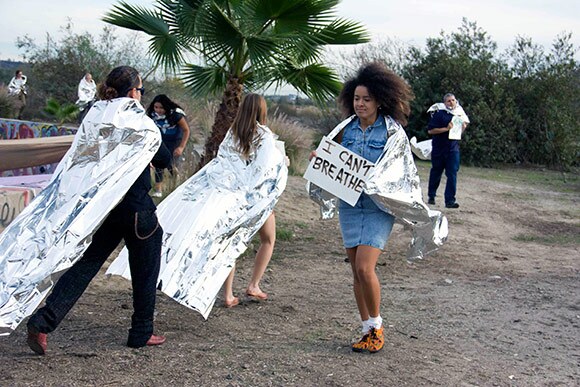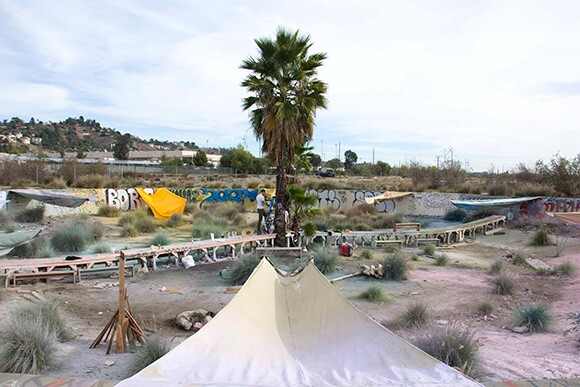Roundhouse Shines: Conversations on the River

Join Play the LA River to explore, enjoy, reclaim, and reimagine the river as a grand civic space that can green and connect our communities.
As the sun turned a deep red orange on the horizon, silver-caped bodies dashed, bounded, strolled around a graffiti covered 126-foot diameter train turnaround, outfitted with twelve equidistant canopies installed in the round and bisected by a large table made from trash found along the site.
Metal music blared from the speakers in the center, as the players (who were really draped in silver thermal blankets) alternately held up signs that daringly stated "Hands up, don't shoot," "I can't breathe," or whimsically depicted a sun, a moon, or a rabbit.
More on the art of protesting
As the music calmed down, the melody switched to "Sharon Jones And The Dap-Kings' "This Land is Your Land" while the players slowly made their way below the canopied cavity of the roundhouse, placeholders for the wanderers perhaps that have sought shelter in the very same spots.

Set on the southern edge of the Bowtie Parcel, "Roundhouse Shines" is the latest site-specific work by provocative artist Olga Koumoundouros, whose work has always dealt with questions of ownership as it relates to class and labor. "The root issue now is not gentrification," Koumoundouros's voice over intones over the speakers during the performance, "but land in a political sense of the word.
Her latest work, "Roundhouse Shines" is no different, but more urgent given the site's confluence of interests. "The river is now eligible for this federal money the state owns this plot of land, the insurance here is paid for a private non-profit," explains Koumoundouros, "You've got city, state, federal and private interests all converging right here. The question of ownership and how it could change here is really ripe."

And there is no better time to unpack these questions than now, right at the spot Koumoundouros has chosen, at the fringes of Los Angeles River property.
The edge has always been a place where raw energy lies, where only the courageous or those without nothing left to lose have trod. Away from the center of any stage, these unseen players find the freedom to experiment, to explore, to claim without constant supervision or challenge. At the roundhouse, graffiti taggers often find the empty space to express themselves and claim their small piece of land with their marks.
Contrary to expectation, Koumoundouros's spot of the land is well-used. "It's used by a lot of people who want to be under the radar, who enjoy that the place is unregulated," says Koumoundouros. "There are kids walking to and from school, people who fish, cyclists who hang out. There are homeless encampments here, some who have been here for as long as three years."
While the Los Angeles River has dramatically opened itself to the public in the last few years, there are those who feel this increased accessibility has conversely resulted in less freedom for these longtime patrons of this river.

Jose Diaz, one of the performers in Koumoundouros's piece, recalls, "People used to be able to get closer to the river." With more public attention on the river, Diaz notes more regulation has been placed on what can and cannot be done on this once neglected Los Angeles feature. Yet, at the same time, this increased supervision has also given the public a sense that the river has become an explored, tamed territory, thus safe for everyone.
"Roundhouse Shines" is rife with such contradictions, which surface starkly when Koumoundouros's performance piece unfolds. Who does own this public park? Who has the right to set its rules? Whose wishes should we adhere to -- the future property owners of the nearby properties or the vagrants that take shelter at this park as their last resort? How much right do people, both landed and unlanded, have?

Koumoundouros's daring installation is part of non-profit Clockshop's ongoing collaboration with California State Parks. Since it began with the unveiling of Michael Parker's "Unfinished," Clockshop has been inviting artists to make work around the Bowtie Parcel in the hopes of catalyzing conversation about the contours and configurations of this future state park.
"Roundhouse Shines" is the most controversial, courageous piece the collaboration has put on to date and it has caused no small amount of discomfort in the parties involved as the artist deals with the Bowtie Parcel's transformation from being an under-the-radar, unregulated plot of land to a regulated, state-run facility, with Koumoundouros at its epicenter.
Working at the site from August to October this year, Koumoundouros found herself face to face with the riverside's residents. "From the beginning, I was working with the kids that tag and while I was talking to them, I learned that these people felt a sense of ownership over that roundhouse area. I gradually got a sense that even if I was doing something in support of the site, I was still taking something away from them," says Koumoundouros. "But I didn't know that at first."

Though there were people who would work alongside Koumoundouros, adding their own marks to Olga's piece, there were those that hid as she approached, who saw her as harbinger of unwelcome change. As a result, "Roundhouse Shines" has been the most affected installation at the parcel. "This piece has been targeted a lot," says Koumoundouros. Its canvas shade structures were routinely slashed and its constructed benches regularly smashed.
Not only did the artist face tensions by the land's current users, Koumoundouros also grappled with the State Parks' own mixed emotions on the questions raised by her work.
The artist admits, the agency's ambivalence was probably not helped when Koumoundouros had changed a piece of the "Roundhouse Shines" installation Clockshop, State Parks and the artist had agreed to without informing the agency. Instead of an abstract sculpture under the canvas, the artist had created a horizontal table instead. "That was a breach of their trust, but I had also needed to do something with the community. I didn't talk to them and have the contract renegotiated and I should have," says the artist, when asked about the state agency's reaction to her work.
In response, Sean Woods, L.A. superintendent of California State Parks says, "The important agenda to bring up is revitalization. Koumoundouros's work is part of a larger vision, our collaboration with Clockshop, that deals with larger issues of raising awareness, open space, and the river."
Koumoundouros's six-month run has been shortened to one-month, which ends this Friday. Despite its shortened run, Koumoundouros is gratified by the opportunity. "It was a brave step for the agency," says Koumoundouros, "and was really happy to have that opportunity. The piece and all the changes that kept on happening to it were so alive and dynamic."
When it deals with questions of power and boundaries, art like Koumoundouros's is almost by its nature subversive and to the state's credit, they have allowed a voice such as hers to speak out, no matter how long the duration. It may have only lasted a month, but the questions "Roundhouse Shines" could ring out all the more loudly in the wake of its silence.

